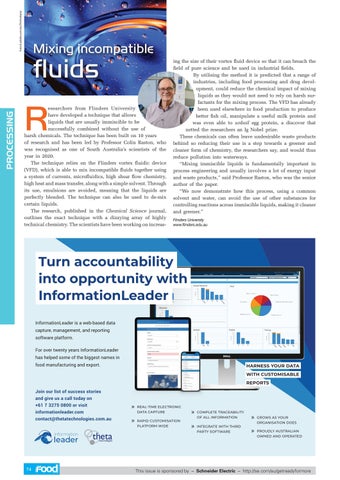©stock.adobe.com/au/Shcherbyna
Mixing incompatible
PROCESSING
fluids
R
esearchers from Flinders University have developed a technique that allows liquids that are usually immiscible to be successfully combined without the use of harsh chemicals. The technique has been built on 10 years of research and has been led by Professor Colin Raston, who was recognised as one of South Australia’s scientists of the year in 2020. The technique relies on the Flinders vortex fluidic device (VFD), which is able to mix incompatible fluids together using a system of currents, microfluidics, high shear flow chemistry, high heat and mass transfer, along with a simple solvent. Through its use, emulsions are avoided, meaning that the liquids are perfectly blended. The technique can also be used to de-mix certain liquids. The research, published in the Chemical Science journal, outlines the exact technique with a dizzying array of highly technical chemistry. The scientists have been working on increas-
74
ing the size of their vortex fluid device so that it can breach the field of pure science and be used in industrial fields. By utilising the method it is predicted that a range of industries, including food processing and drug development, could reduce the chemical impact of mixing liquids as they would not need to rely on harsh surfactants for the mixing process. The VFD has already been used elsewhere in food production to produce better fish oil, manipulate a useful milk protein and was even able to unboil egg protein, a discover that netted the researchers an Ig Nobel prize. These chemicals can often leave undesirable waste products behind so reducing their use is a step towards a greener and cleaner form of chemistry, the researchers say, and would thus reduce pollution into waterways. “Mixing immiscible liquids is fundamentally important in process engineering and usually involves a lot of energy input and waste products,” said Professor Raston, who was the senior author of the paper. “We now demonstrate how this process, using a common solvent and water, can avoid the use of other substances for controlling reactions across immiscible liquids, making it cleaner and greener.” Flinders University www.flinders.edu.au
This issue is sponsored by – Schneider Electric – http://se.com/au/getreadyformore
















